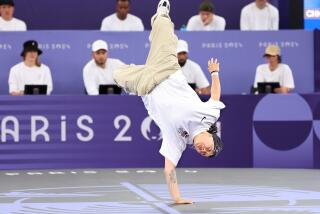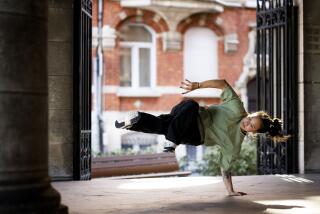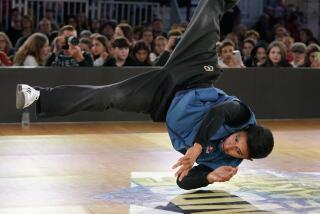Leap of Faith : Bungee Jumping Offers New Thrill by Stretching the Limits of Daredeviltry
- Share via
ANGELES NATIONAL FOREST — Secretly they gathered in the predawn light, a brash air about them, at a dirt lot next to a concrete arch bridge. But as launch time drew near, the 20 thrill-seekers were getting edgy about hurling themselves over the metal railing, with nothing but wrist-thin elastic ropes saving them from the rocky ground 130 feet below.
“This is insane,” cried one young waitress who moments before had boldly announced she would be the first to jump.
“Why are we doing this?” said a college student and one-time sky diver.
“I sure hope the lengths of the ropes weren’t miscalculated,” said a friend, whose gaze was fixed on the mammoth bridge on a back road of the Angeles National Forest outside Los Angeles.
Despite their fears, the daredevils willingly paid $79--now up to $99--to a Huntington Beach-based company to make two giant leaps and join an elite group of psychological athletes who participate in this growing sports craze known as bungee jumping.
“Almost everybody is frightened before they jump, many haven’t been able to sleep for days and other just can’t stand still,” said Ricco Nel, president of California Bungee and organizer of the recent weekend event.
As the sun crept over the mountaintops, Nancy Gorrell prepared to make the first jump of the day. The 24-year-old waitress from Los Angeles struggled with a case of the pre-jump jitters as Nel strapped three 40-foot bungee cords to her parachute-style harness.
“I have never been so terrified in my entire life, nor will I ever be more terrified. This is crazy,” she declared as she hopped over the railing and stood on the ledge.
A five-second countdown later, she flung her body from the bridge and plummeted face first toward the rocks and shrubs below, reaching a speed of 40 m.p.h. before the cords started to stretch and slow her descent. When she was about 30 feet from the ground the bungees reversed her direction, rocketing her limp body skyward to about 80% of her original leap.
After several bounces, Gorrell was hauled back up to the bridge amid shouts of applause by her friends.
“I couldn’t even scream,” she beamed. “I was too scared. All the way down I kept thinking, ‘What am I doing? What am I doing?’ You just spring and then twang . . . it’s incredible!”
After Gorrell’s jump, Scott Bergman, a veteran jumper and employee with California Bungee, looked at the men in the group who were twitching nervously and reminded them that a female had gone first and there was “no turning back now, guys.”
And so it went on this sunny weekend morning. Each jumper emerged with a different description of his or her harrowing descent.
“If you’re going to commit suicide, this is definitely the way to do it,” said Tad Rogers, a 21-year-old student at UCLA. “It’s fun on the way down.”
Geoff Todosiev, 25, of San Pedro came up from his jump and said: “I kept inhaling all the way down. I had no idea I had so much lung capacity. This was an absolute rush. It seemed like I came really close to hitting the bottom.”
Bungee jumping’s popularity is growing rapidly in California despite the fact that jumping from public bridges or overpasses can violate trespassing and public-nuisance laws. Also, no insurance company will cover the sport.
The activity’s origins lie in ancient rites of passage practiced in South Pacific countries such as New Caledonia and the New Hebrides. Natives would collect vines, weave them into long cords, tie them around their ankles and jump from tall trees or cliffs as a test of their manhood.
In this country, a form of bungee jumping was introduced in circus acts during the 1920s. It became an adventure sport in 1979, when five members of Oxford University’s Dangerous Sports Club, dressed in tuxedos with top hats, jumped off the Golden Gate Bridge.
Bungee jumping has received increased attention lately because of a Reebok International shoe commercial that featured two bungee jumpers tethered at the feet. One jumper, wearing Reebok shoes, and another jumper, wearing the competition’s footwear, jump from a bridge. At the end of the jump, the Reebok wearer is shown dangling upside down. Next to him are the competition’s shoes, sans jumper, who presumably fell to the gorge below. The ad was pulled after a short time on the air.
Currently, bungee jumping is extremely popular in Australia, New Zealand, France and California, especially in the northern part of the state where high bridges are more plentiful.
In the Southland, Ricco Nel’s California Bungee has helped more than 1,800 adventure seekers make successful jumps during its 18 months of operation. The company is the only one of its kind in Orange County and one of about six in the state.
“The number of calls I get from people wanting to jump is overwhelming,” Nel said. “It’s really catching on.”
Although there are no laws specifically against bungee jumping, there are trespassing laws that prohibit a person’s center of gravity from going beyond the railing of a public bridge or overpass.
This has caused bungee jumpers to find remote bridges, far from the scrutiny of police--unless, of course, police are doing the jumping, Nel said.
“I once jumped 15 off-duty police officers from L.A.” he said. “They had a great time.” However, Nel said he and his partners have encountered on-duty officers who told them to pack up their equipment and leave.
Because of the legal issues, Nel organizes early morning trips, such as the recent jump. “We don’t want be to blatant about it,” he says.
In addition to the trespassing issue, officials with the California Highway Patrol said, jumpers could be cited for being a disturbance to motorists.
“These people who attach themselves to elastic cords and jump from bridges could create quite a distraction for motorists,” CHP spokesman Sam Haynes said. “I think it’s safe to say we’re opposed to it.”
Still, because the sport is in its infancy in this country, law enforcement agencies haven’t targeted the jumpers and no formal opposition groups have organized.
To avoid legal problems, Nel said he plans to start jumping people from a hot air balloon. At least one company in Northern California, Bungee Adventures, also uses hot air balloons.
Another problem bungee jumping companies face is insurance: They have none.
“So far nobody wants to touch us,” Nel said. “They don’t realize how safe the sport actually is.” In the meantime, he has his clients sign liability waviers.
As far as most experts can tell, there have been no bungee-related fatalities in the United States. There have been at least three such deaths in France, they said.
The worst injuries that Nel says he has seen are minor rope burns that occur when jumpers hold onto the cords or get tangled up in the lines. “We call them bungee kisses,” he said.


